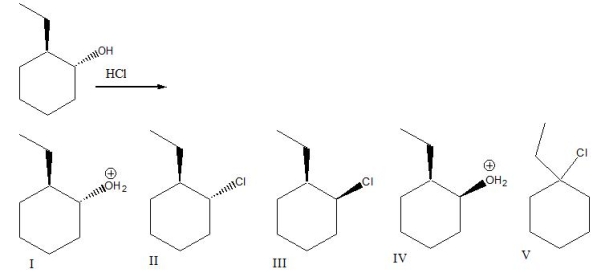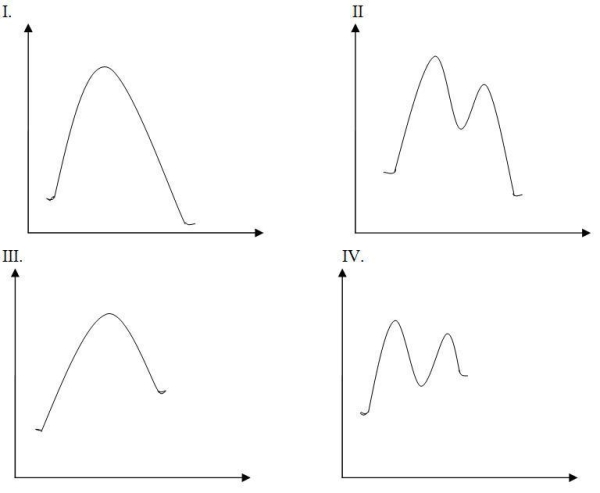A) I
B) II
C) III
D) IV
E) All of these
Correct Answer

verified
Correct Answer
verified
Multiple Choice
Consider the following SN2 reaction,  Assuming no other changes, what is the effect on the rate, if the concentration of 2-bromopentane is doubled and the concentration of CH3CH2COONa is halved?
Assuming no other changes, what is the effect on the rate, if the concentration of 2-bromopentane is doubled and the concentration of CH3CH2COONa is halved?
A) No effect
B) It would double the rate
C) It would triple the rate
D) It would increase four times
E) It would reduce by half
Correct Answer

verified
Correct Answer
verified
Essay
Provide a curved arrow mechanism for the following reaction. 
Correct Answer

verified
Correct Answer
verified
Multiple Choice
Predict the product for the following SN2 reaction. 
A) I
B) II
C) III
D) IV
E) Both I & II
Correct Answer

verified
Correct Answer
verified
Multiple Choice
What substitution reaction mechanism is most likely for the following conversion? 
A) SN1
B) SN2
C) Either SN1 or SN2
D) None of these
Correct Answer

verified
Correct Answer
verified
Multiple Choice
Draw the transition state for the following reaction. 
A) I
B) II
C) III
D) IV
Correct Answer

verified
Correct Answer
verified
Multiple Choice
What is the electrophile in the following reaction? 
A) I
B) II
C) III
D) IV
Correct Answer

verified
Correct Answer
verified
Essay
Draw the transition state for the following reaction. (S)-1-iodo-3-methylpentane +NaSCH3
Correct Answer

verified
Correct Answer
verified
Multiple Choice
Which of the following is a strong nucleophile?
A) OH-
B) H2O
C) CH3OH
D) NH4+
E) All of these
Correct Answer

verified
Correct Answer
verified
Multiple Choice
Predict the major product for the following reaction. 
A) I
B) II
C) III
D) IV
E) V
Correct Answer

verified
Correct Answer
verified
Multiple Choice
Which of the following compounds will undergo the fastest SN1 reaction? 
A) I
B) II
C) III
D) IV
E) Both I & IV
Correct Answer

verified
Correct Answer
verified
Essay
Predict the product for the following reaction.
(1R, 3S)-1-bromo-3-sec-butilcyclopentane + NaN3

Correct Answer

verified
Correct Answer
verified
Multiple Choice
Which of the following is a protic solvent? 
A) I-
B) II-
C) III
D) IV
E) none of these
Correct Answer

verified
Correct Answer
verified
Multiple Choice
What is the correct structure for 2-bromo-3-methylbutane? 
A) I
B) II
C) III
D) IV
Correct Answer

verified
Correct Answer
verified
Multiple Choice
Which of the following is the rate equation for the following reaction? CH3CH2CH2CHBrCH3 + NaN3 CH3CH2CH2CHN3CH3 + NaBr
A) Rate = k[CH3CH2CH2CHBrCH3]
B) Rate = k[NaN3]
C) Rate = k[CH3CH2CH2CHBrCH3] [NaBr]
D) Rate = k[CH3CH2CH2CHBrCH3] [NaN3]
E) Rate = k[CH3CH2CH2CHBrCH3]2 [NaN3]
Correct Answer

verified
Correct Answer
verified
Multiple Choice
Rank the following compounds from most to least reactive in an SN2 reaction. 
A) I>IV>II>III
B) II>I>IV>III
C) III>IV>I>II
D) I>III>II>IV
E) IV>III>I>II
Correct Answer

verified
Correct Answer
verified
Multiple Choice
Provide the reagents necessary to carry out the following conversion. 
A) NaCl in water
B) NaCl in ether
C) HCl in water
D) TsCl/pyridine followed by NaCl
Correct Answer

verified
Correct Answer
verified
Multiple Choice
Which of the following alkyl halides will undergo the slowest SN2 reaction? 
A) I
B) II
C) III
D) IV
E) V
Correct Answer

verified
Correct Answer
verified
Multiple Choice
Which of the following potential energy diagram represent an exothermic SN1 reaction? 
A) I
B) II
C) III
D) IV
Correct Answer

verified
Correct Answer
verified
Multiple Choice
Which of the following is a secondary alkyl halide?
A) (CH3) 2CHCH2Cl
B) (CH3) 2CClCH3
C) (CH3) 2CHCHClCH3
D) (CH3) 2CHCH2CCl(CH3) 2
Correct Answer

verified
Correct Answer
verified
Showing 41 - 60 of 123
Related Exams